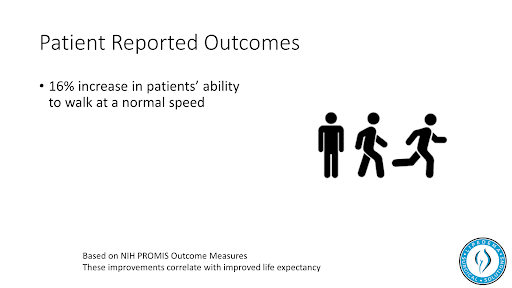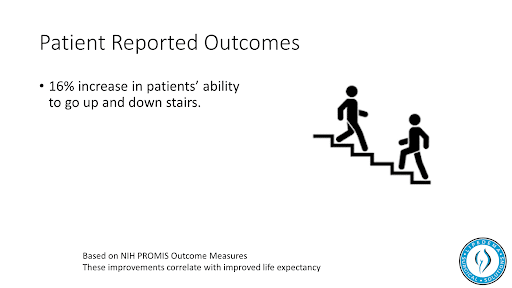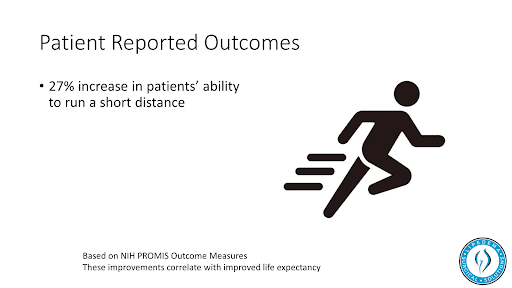Orthopedic, Lymphatic, & Mobility Complications are just a few things ways mobility is negatively affected for women with Lipedema.
Lipedema, a condition characterized by the abnormal accumulation of fat tissue, often leads to significant orthopedic and lymphatic complications if left untreated. Without lipedema reduction surgery, the likelihood of developing these lipedema complications increases drastically, impacting patients’ mobility, quality of life, and finances.
Orthopedic Complications of Lipedema
One of the primary effects of lipedema is its impact on skeletal alignment due to the bulk of the lipedema tissue. This extra weight puts added stress on the hips, knees, ankles, and arches, accelerating the onset of arthritis in these areas. Unfortunately, arthritis and lipedema tend to exacerbate each other, creating a vicious cycle of joint pain and degeneration. Many patients with stage 2 or 3 lipedema require joint replacements,
Lipedema tissue creates bulk forces that distort the skeletal alignment of afflicted individuals. Lipedema increases stresses on the medial compartment of hips, knees, ankles, and arches. This accelerates arthritis in the hips, knees and ankles. The lipedema compounds these arthritic changes, and the lipedema compounds the arthritic conditions, creating a vicious circle. Dr. Wright has treated countless stage 2 or 3 lipedema patients who have undergone knee or hip replacement surgery, but these surgeries often don’t resolve the pain due to the underlying condition.
Knee Pain and Failed Knee Replacements
Focusing on the knee pain and degeneration in lipedema patient, approximately 90% of lipedema patients have knee pain. A large percentage of women with stage 3 lipedema have knee pain and degeneration, necessitating knee replacement surgery. In Dr. Wright’s practice, 10% of all lipedema patients (a higher percentage in the advanced lipedema stages) have continued knee pain, inadequate range of motion, and severely limited mobility after knee surgery. These are considered failed knee replacements, and there are several reasons why lipedema patients are at risk for failed knee replacements. This is often due to the misalignment of the legs caused by lipedema bulk. The limited range of motion—typically between 90 to 105 degrees—sets patients up for failure, as successful knee replacements require 105 to 120 degrees of flexion.
Most Common Reasons Knee Replacements Fail
- The misalignment of the legs and stance from the lipedema bulk and continued medial stresses on the medial knee.
- Many women with lipedema have limited knee range of motion, just by the bulk effect, and are limited to 90-105 degrees. This sets up for failure of a knee replacement, and a knee replacement is considered a failure if you cannot get at least 105-120 degrees of flexion.
Note: Knee replacement revision surgeries have higher rates of infection, and about 10% of lipedema patients have unsuccessful or failed knee replacement surgery. The percentage is higher for more advanced-stage lipedema.
The Average Cost of Total Knee Replacement (TKR)
The average cost of a total knee replacement (TKR) in 2020 ranged from $30,000 to $50,000. Revision surgeries, particularly in Medicare patients, averaged $76,000, with hospitalization lasting around six days. Since lipedema usually affects both knees, the total cost for knee-related complications in advanced-stage patients can easily double. So, the average cost of knee replacement and revision with advanced lipedema knee pain can be calculated as follows:
- Initial knee replacement or TKR of $30,000 – 50,000.
- Average Medicare reimbursement of $40,000 X 2 = $80,000.
- Revision TKR (range of cost $60,000 – 100,000) average cost is $76,000 X 2 = $152,000.
- Knee complications from lipedema total $80,000 plus $152,000, which equals $232,000.
- Total potential cost: $232,000.
Hip Joint Complications in Lipedema
While less common than knee issues, hip degeneration is another frequent complication of lipedema. The average cost of hip replacement surgery is $39,000. Like the knees, lipedema tends to affect both hips, doubling the price to $78,000 for many patients.
- The cost of hip replacement surgery ranges from $23,000 to $74000 with the average cost of total hip replacement surgery of $39,000.
- The complications of hip joint degeneration are symmetrical, so the cost doubles for most lipedema patients as both hips are involved $39,000 X 2 equals $78,000.
- Total potential cost: $78,000
Other Joint Lipedema Complications
Ankle, heal and plantar pain and degeneration are much more common in lipedema patients than patients without lipedema. While these orthopedic complications can be costly, we have not included an estimate of their cost.
Lymphatic Complications
Lipedema can lead to lymphatic complications, either from the progression of the disease or from damage caused by liposuction or surgical treatment, such as debulking or skin removal.
Untreated lipedema progresses to cause secondary lymphedema in 60%-80% of patients with Stage 3 lipedema. Lymphedema of the extremities increases the risk of infection, skin breakdown, and skin cancer and leads to progressive deformity and fibrosis of the limbs and increasing immobility. In 2016, Deonni reported that 70% of patients with lower limb lymphedema had significantly impaired mobility. Nearly a third of patients with lower limb lymphedema experienced significantly impaired mobility enough to limit their ability to work which can lead to partial or complete disability.
Lipedema, by its nature, has impaired lymphatic function, and lipedema patients are at increased risk for lymphatic injury from surgery that reduces the amount of lipedema tissue. I have multiple lipedema patients who have undergone surgical intervention of their lipedema and have developed secondary surgical lymphedema as a result. Unfortunately, these ladies will have permanent lymphatic flow issues due to poor lymphatic transport because of inadequate safeguards to protect the lymphatic system. Secondary surgical lymphedema in these patients compound and likely doubles the risk for surgical infection, skin ulceration, additional progressive limitations of mobility, and at high risk of permanent disability.
Lymphatic Surgical Interventions
Lipedema patients are also at risk for lymphatic damage from surgery. This can lead to secondary lymphedema, causing permanent lymphatic issues. Lymphedema treatment typically includes lifelong compression therapy, physical therapy, and surgical interventions like lymph node transfer (LNT) or lympho-venous bypass (LVB). However, these surgeries have high failure rates—44% for LNT and 21% for LVB. When surgery fails, revisions are often necessary, further driving up costs.
Treatment of lymphatic complications of lipedema is expensive. Lymphedema patients require lifelong compression and often ongoing physical and occupational therapy. Patients with lymphedema have a significantly increased risk of hospitalization for skin infection and septicemia. Lymphedema is treated surgically primarily with lymph node transfer (LNT) and lympho-venous bypass (LVB). According to Sekigami in 2021, the average cost of LNT is $22,492, and the average cost of lympho-venous bypass is $31,927. Both surgical treatments have high failure rates. The failure rate of LNT was 44%, and LVB is 21%, often requiring surgical revision. Surgical revision costs are as high as 44% in surgically treated lymphedema patients. This means the total surgical cost per patient per limb could easily be twice that of a single surgery. Again, as lipedema universally affects both lower extremities, the cost can be four times that of a single surgical intervention, so the cost estimate should range from $22,000 to $128,000.
Lymph node Transfer (LNT) and Lympho-venous Bypass (LVB) Costs:
- LNT surgery cost: $22,492.
- LVB surgery cost: $31,927.
- With the high failure and revision rates, the cost can easily double, and because lipedema affects both limbs, the total surgical cost can range from $22,000 to $128,000.
Secondary lymphedema leads to increased hospitalization costs, ongoing therapy costs, and surgical treatment costs, which range from $22,000 to $128,000. Close to one-third of lipedema patients with secondary lymphedema develop partial or complete disability.
Deconditioning and Mobility Complications in Lipedema
Lipedema significantly impacts a patient’s mobility due to the progressive nature of the disease and the accumulation of painful, heavy tissue, primarily in the legs and lower body. Over time, this added bulk and pressure on the joints and muscles lead to a gradual decrease in physical activity, causing deconditioning—the weakening of muscles and overall physical function from a lack of movement. PROMIS (Patient-Reported Outcomes Measurement Information System) data on mobility in lipedema patients shows that the average mobility level of lipedema patients is significantly lower than that of individuals without the condition. This decline in mobility is not only caused by the pain and discomfort associated with lipedema but also by the compounding orthopedic and lymphatic complications, such as arthritis, joint deformities, and swelling from lymphedema.

Normal T-Score is 50%, but for Lipedema patients their T-score is around 36%, 14 points below average. This is 3-4 standard deviations below normal. Lipedema is associated with highly significant decreases in overall mobility.
The Risks of Decreased Mobility
Reduced mobility in lipedema patients can have serious long-term health consequences:
- Increased Risk of Early Mortality:
Decreased physical activity leads to a range of secondary health issues, including cardiovascular disease, diabetes, and respiratory problems, all of which increase the risk of early death. Studies have shown that individuals with restricted mobility have a higher likelihood of developing life-threatening conditions such as heart disease due to the lack of physical activity needed to maintain heart health and circulation. - Development of Disability:
As mobility decreases, the risk of developing permanent disability rises. A lack of movement exacerbates joint degeneration, muscle wasting, and balance issues, making it increasingly difficult for patients to perform daily activities or maintain independence. For many lipedema patients, this reduced mobility can lead to the need for assistive devices, such as walkers or wheelchairs, and in severe cases, can result in total reliance on caregivers. - Impaired Quality of Life:
The loss of mobility not only impacts physical health but also takes a toll on mental health. Many patients experience a reduction in their quality of life due to chronic pain, social isolation, and the inability to engage in previously enjoyed activities. Depression and anxiety are common among those with advanced lipedema, further complicating their ability to remain physically active.
Mobility Data and Clinical Observations
PROMIS mobility data highlights that lipedema patients are frequently in the lower range of mobility scores when compared to the general population, indicating that they struggle significantly with movement. Many patients report difficulty with walking, standing for extended periods, or climbing stairs. As lipedema progresses to more advanced stages, mobility becomes increasingly limited, leading to more severe complications.
The complications of lipedema, including orthopedic, lymphatic, and mobility issues, can lead to an overwhelming financial burden. Surgical interventions like knee and hip replacements, alongside treatments for lymphedema, can cost hundreds of thousands of dollars. In many cases, lipedema patients face long-term disability, further compounding the cost of care.

Individually, things like decreased walking speed is associated with early mortality.


